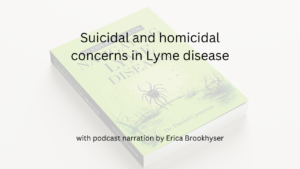Call for your appointment today 914-666-4665 | Mt. Kisco, New York

Welcome to my next Inside Lyme podcast. – I will be discussing the risk of fecal transmission of COVID-19 in children. You may be wondering why I am discussing COVID-19 during an Inside Lyme podcast. I am concerned for my children, grandchildren, and my patients. I would like to share my understanding of COVID-19 through my eyes as a clinical epidemiologist.
I have learned that the best way to understand a COVID-19 infection is through a discussion of actual cases.
A family cluster of COVID-19 infections
Chan and colleagues described a familial cluster of pneumonia associated with COVID-19 in the journal Lancet . “Of six family members who traveled to Wuhan, five were identified as infected with the novel coronavirus.” wrote the authors. That included a father, daughter, son-in-law, grandson, and two mothers. One of the family members did not travel but became infected after several days after contact with the family wrote Chan and authors. The family members did not all wear masks.
The five adults were ill with “fever, upper or lower respiratory tract symptoms, or diarrhea, or a combination of these 3–6 days after exposure.” wrote Chan and colleagues. A 10-year-old child was not ill with COVID-19 infection but had ground glass lung opacities by chest CT.
Chan and colleagues concluded, “Our findings are consistent with person-to-person transmission of this novel coronavirus in hospital and family settings, and the reports of infected travelers in other geographical regions.”
Transmission questions about COVID-19 in children
Most of us are aware of the risk of respiratory transmission of COVID-19. Children can present with upper and lower respiratory infection, writes Cruz and colleagues in Pediatrics in 2020.
I was surprised to run across the question of fecal transmission of COVID-19 to children in the same article by Cruz and colleagues. “There is also evidence of fecal shedding in the stool for several weeks after diagnosis, leading to concern about fecal-oral transmission of the virus, particularly for infants and children who are not toilet-trained, and for viral replication in the gastrointestinal tract.”
[bctt tweet=”I discussed the potential risk of fecal transmission of COVID-19 in children in my latest Inside Lyme podcast.” username=”DrDanielCameron”]
Cai and colleagues described viral shedding in feces in five children in the journal Clinical Infectious Diseases . “these 5 patients still have 2019-nCoV RNA detected in feces within 18-30 days after illness onset.”
Public health challenges regarding COVID-19 in children
Half of the children with a COVID-19 infection can present without a fever or symptoms of an acute respiratory tract infection write Dong and colleagues. “Some cases may have no fever, or have only digestive symptoms such as nausea, vomiting, abdominal pain and diarrhea.” The authors added, “Physical examination shows congestion of the pharynx and no auscultory abnormalities.
Cruz and colleagues raise an important public health concern for daycare centers, schools, and in the home. “Prolonged shedding in nasal secretions and stool has substantial implications for community spread in daycare centers, schools, and in the home.” That would also include the elderly who help their grandchildren.
What can we learn from these cases?
- Children with COVID-19 can present with acute upper respiratory infection rather than a lower respiratory infection e.g., pneumonia.
- Children with COVID-19 can present without a fever.
- Children with COVID-19 can present with nausea, vomiting, abdominal pain, and diarrhea.
What questions do these cases raise?
- Without a fever, without symptoms of an acute respiratory infection, and a normal auscultory exam of the chest, how is a doctor, parent, grandparent, or caregiver going to recognize COVID-19 in children?
- How many children with symptoms of upper respiratory infections have COVID-19?
- How important is fecal transmission of COVID-19 in children?
- Do we need to warn parents, grandparents, daycare centers of the risks?
Inside Lyme Podcast Series
This Inside Lyme case series will be discussed on my Facebook and made available on podcast and YouTube. As always, it is your likes, comments, and shares that help spread the word about this series and our work. If you can, please leave a review on iTunes or wherever else you get your podcasts.
Sign up for our newsletter to keep up with our cases.
References:
- Chan JF-W, Yuan S, Kok K-H, To KK-W, Chu H, Yang J, et al. A familial cluster of pneumonia associated with the 2019 novel coronavirus indicating person-to-person transmission: a study of a family cluster. Lancet 2020.
- Cruz A, Zeichner S. COVID-19 in children: initial characterization of the pediatric disease. Pediatrics. 2020.
- Dong Y, Mo X, Yabin Hu Y, Qi X, Jiang F, Jiang Z, Tonga S. Epidemiological Characteristics of 2143 Pediatric Patients With 2019 Coronavirus Disease in China. Pediatrics.
- Cai J, Xu J, Lin D, Yang Z, Xu L, Qu Z, Zhang Y, Zhang H, Jia R, Liu P, Wang X, Ge Y, Xia A, Tian H, Chang H, Wang C, Li J, Wang J, Zeng M. A Case Series of children with 2019 novel coronavirus infection: clinical and epidemiological features. Clin Infect Dis. 2020 Feb 28. pii: ciaa198.



